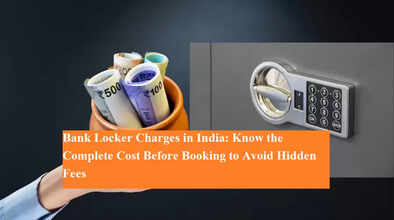Bank Locker Charges in India: Know the Complete Cost Before Booking to Avoid Hidden Fees

Banks across India offer secure locker facilities to safeguard valuable items like jewelry, documents, and other personal assets. While this service ensures safety, it comes at a cost — and the charges can vary significantly depending on locker size, location, and the bank’s own policies. Before signing up for a locker, customers should be aware of not only the annual rent but also additional fees that can make the service more expensive than expected.
Annual Locker Rent Depends on Size and Location
The yearly rental for bank lockers is based on two main factors: the size of the locker and the location of the branch. Metropolitan branches generally charge more than rural branches. Rent is usually paid in advance for the entire financial year. As per Reserve Bank of India (RBI) rules, banks must also provide a signed copy of the locker agreement to the customer, clearly detailing rights, responsibilities, and all applicable fees.
Common Additional Charges You Should Know About
-
One-Time Registration Fee – Charged when the locker is first allocated. This covers documentation and administrative processes linked to the locker holder’s account.
-
Exceeding Free Access Limit – Banks allow a fixed number of free visits to your locker each year. Using the locker beyond this limit incurs an additional fee per visit.
-
Overdue Locker Rent Penalty – If the annual rent is not paid on time, the bank may charge a penalty for the delay.
-
Forced Locker Breaking Fee – If the customer fails to pay rent, loses the locker key, or requests the bank to open the locker forcibly, charges apply for lock replacement, labor, and related formalities.
-
Key Replacement Charges – For example, HDFC Bank charges customers for replacing a lost locker key. The process is carried out by an authorized vendor in the presence of both the locker holder and a bank official.
FD Requirement for Locker Allocation
Some banks require customers to open a fixed deposit (FD) covering at least three years’ rent and the cost of breaking the locker, in case of default. However, State Bank of India (SBI) clarifies that it does not require existing locker holders to maintain an FD for continued use.
For smooth locker operations, customers must:
-
Comply with Know Your Customer (KYC) norms.
-
Maintain an active savings or current account for at least three years.
-
Keep an average balance equivalent to two years’ locker rent over the past year.
Compensation in Case of Theft or Damage
Banks are legally responsible for preventing losses due to fire, theft, burglary, building collapse, or robbery — provided the loss is caused by negligence, shortcomings, or fraud by bank staff. If valuables stored in a locker are lost under such circumstances, the bank must compensate the customer with an amount equal to 100 times the annual rent of the locker.
Bottom Line
While bank lockers remain one of the most secure ways to store valuables, customers should factor in all potential costs before booking one. Knowing the rent structure, additional fees, and compensation policies will help you make an informed decision — and avoid unpleasant surprises later.

